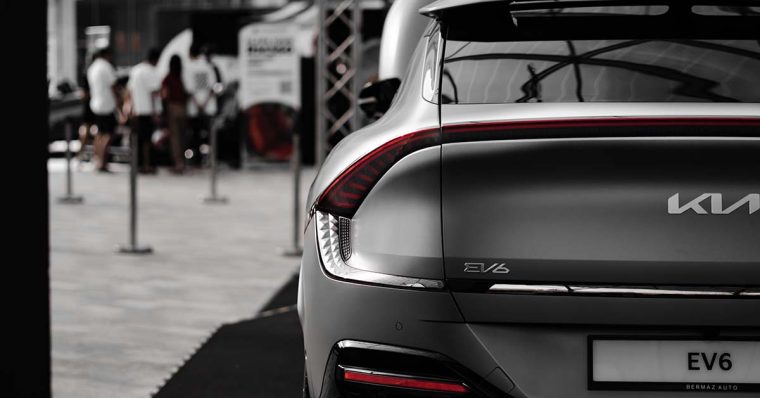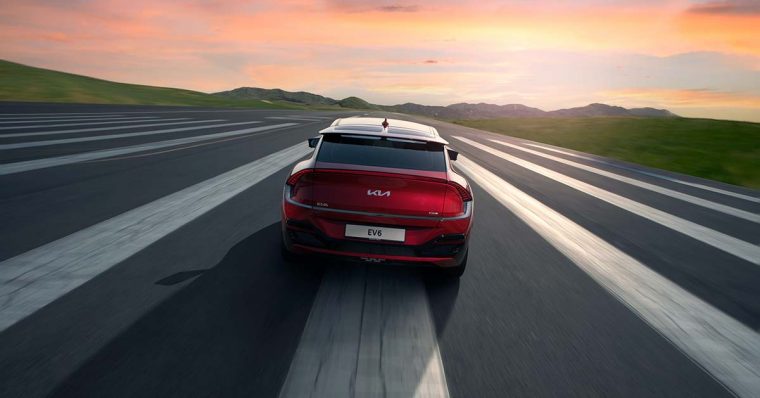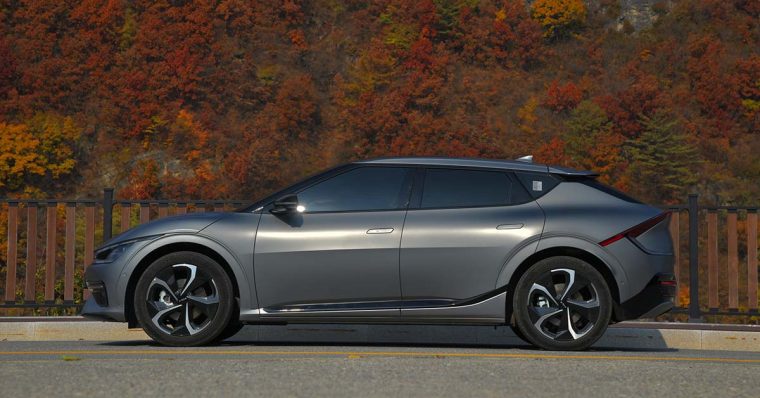
Kia EV6 Review
DriverKia has escaped from the bargain basement.
And this car, the EV6, showcases how far the South Korean car maker, which not all that long ago was regarded as a cheap and cheerful brand that appealed purely on price, has come in a relatively short period of time.
The EV6 is the company’s first dedicated battery electric vehicle and sets some ground-breaking foundations for 14 new EVs to come over the next few years. It will be joined later this year by the EV9, a large seven-seat SUV that recently made its global debut and followed by a smaller EV5 within the next 18 months. Kia is also expected to leapfrog established rivals in the light commercial market with a fully electric version of its upcoming dual-cab ute as well as introduce an affordable entry-level EV before 2026.

The EV6 is a five-door, five-seat hatchback, similar in size – and a direct rival – to the popular Tesla Model 3 and utilises the same e-GMP platform that underpins the Hyundai Ioniq 5 and Ioniq 6, as well as the Genesis GV60, from its sister brand.
It is available in New Zealand in five model variants across four trim levels – Air, Earth, GT-Line and GT – with prices starting at $76,990 (plus on-roads) and topping out at $139,900 (plus on-roads).
Each model offers different levels of performance – both in terms of power outputs and driving range – owing to their individual configurations.
The entry-level Air is exclusively offered with a single motor that drives the rear wheels and is available in Standard Range (with a 58.0kWh battery) or Long Range (with a 77.4kWh battery) variants.
In the Standard Range model, the engine generates 125kW of power and it can travel up to 394km on a single charge while in the Long Range, it produces 168kW and has a claimed driving range of 528km.
The mid-grade Earth and GT-Line both have a twin-motor, all-wheel drive configuration with 239kW/605Nm, powered by the larger 77.4kWh battery pack and can travel 506km and 484km respectively on a single charge.
The flagship GT is only available with a high-performance twin-motor, all-wheel drive set-up that generates supercar outputs of 430kW and 740Nm. It can accelerate from 0-100km/h in around 3.5 seconds but has the lowest driving range of 424km.

The 77.4kWh lithium-ion battery pack is only of one a handful with 800V charging capabilities (the Hyundai Ioniq 5/6, Genesis GV60 and Porsche Taycan models are the others) which means it can take full advantage of the most powerful 350kW ultra-rapid charging stations. Kia claims the battery can be replenished between 10-80 per cent in approximately 18 minutes, and around 73 minutes on a 50kW DC charger.
Even at the entry point, the EV6 Air is fitted with a generous list of standard equipment that includes cloth and synthetic leather trim, dual-zone climate control with second-row air vents, wireless phone charger and twin 12.3-inch digital displays for the instrument cluster and infotainment system, which incorporates digital radio, sat nav, Bluetooth and smartphone mirroring and a six-speaker audio system.
It is also equipped with a comprehensive suite of advanced safety systems, such as autonomous emergency braking, adaptive cruise control, lane keeping assist, Blind Spot Collision Avoidance, front and rear parking sensors and a reverse camera.
The Earth model picks up a few additional extras, such as vegan leather trim, a power-adjustable passenger seat, heated front seats and steering wheel, a head-up display with augmented reality, parking collision avoidance, a blind spot monitor and a 360-degree reverse camera display.

On top of all that, the GT-Line has larger 20-inch alloy wheels, body-coloured exterior highlights, suede interior trim, heated and ventilated front seats, active sound design, a heat pump, a more advanced forward collision warning system and adaptive high beams.
Apart from the additional power output, the top-of-the-range GT gets unique sports seats, neon green brake callipers, Matrix LED headlights, and heated rear seats.
All EV6 models have a five-star ANCAP safety rating and are backed by Kia’s seven-year warranty with capped-price servicing and roadside assistance.
We’re testing the EV6 Air Long Range to see if it is all the electric car you need.
For starters, the EV6’s exterior design is a knockout, and you could easily be forgiven for mistaking it for a genuine European luxury sedan. Its wedge-like silhouette masks its physical dimensions well as it casts a much larger footprint than it appears.
Measuring 4680mm, 1880mm wide and 1550mm tall, the EV6 is roughly the same size as a traditional large sedan. But because of the packaging benefits from its skateboard-like platform, with the battery mounted under the floor – as well as the compact electric motors – it allows the wheels to be pushed to each corner to create a much longer wheelbase (2900mm).
The major benefit of this becomes evident as soon as you open the door into the cavernous interior, which offers a huge amount of space – enough room for five adults to travel comfortably – as well as a flexible cargo carrying area. The boot offers 490L of space with the back seats in place, and up to 1270L when they are folded down. Plus, there’s an additional 52L front trunk – or frunk – under the bonnet, which is big enough to store the charging cable or a small day bag.

From the driver’s seat, the wow factor continues thanks to the bold, yet hugely practical, interior design; from its unique twin-spoke steering wheel to the floating space-age centre console, the ‘fake’ fabric on the dashboard and the twin digital screens.
Thanks to its minimalist layout, all the major controls are easy to use and ergonomically well placed. The starter button and gear selector rotary dial are positioned close together on the front of the centre console, which makes getting started a simple process, the aircon controls are clearly marked, and the wireless phone charger is right where it should be.
The instrument panel could be better designed though, as the bar graphs for speed and power usage take up too much space on the screen which means the steering wheel can obstruct the digital speed and driving range readouts in some seating positions.
But there is plenty of adjustment in the front seats to suit most drivers, and they offer good support and comfort for long-distance driving.
As for how it drives, the electric motor is smooth and seamless and offers more than enough punch when you ask for it. It genuinely asks the question of why you’d need more power, other than for the face-warping, full-throttle novelty factor.

It is also ultra-efficient too, as we recorded an average energy consumption figure of 14.6kWh/100km during our week-long test that included both urban and freeway driving, which means we would have exceeded Kia’s 528km driving range estimate. Just!
As for the rest of the package, its dynamic character is well balanced between comfort and control thanks to localised tuning of its suspension and steering, and the cabin is well insulated from road and wind noise – further adding to its sophistication.
At the end of it all, this is a genuine game changer for Kia, and a real standout among the growing league of electric cars available in New Zealand today. It doesn’t look, drive or feel like any other car from the South Korean car maker, and yet doesn’t deviate too far from its reputation for value.
Sure, it’s still not cheap, but you don’t feel short-changed in the entry-level Air. In fact, it probably offers more than you’ll ever need.
If you’re interested in transitioning to zero-emission motoring, contact SG Fleet today for more information.
 Driving Insights
Driving Insights




